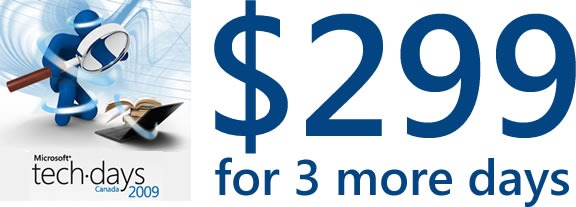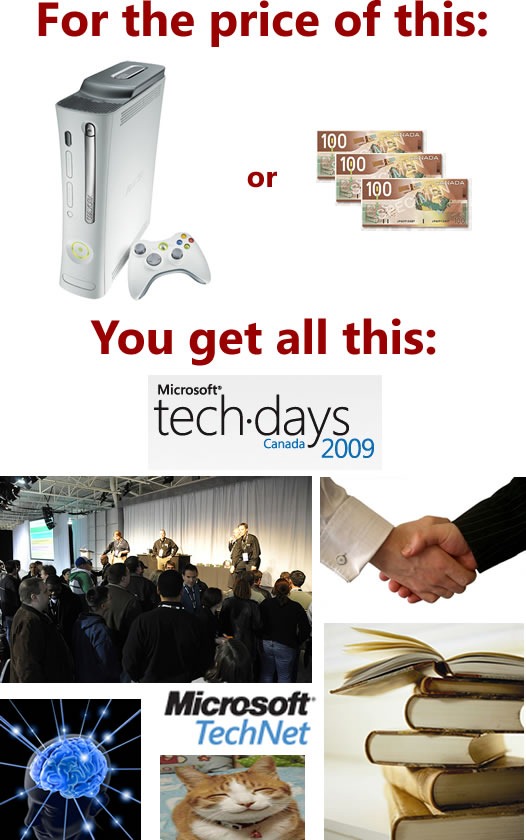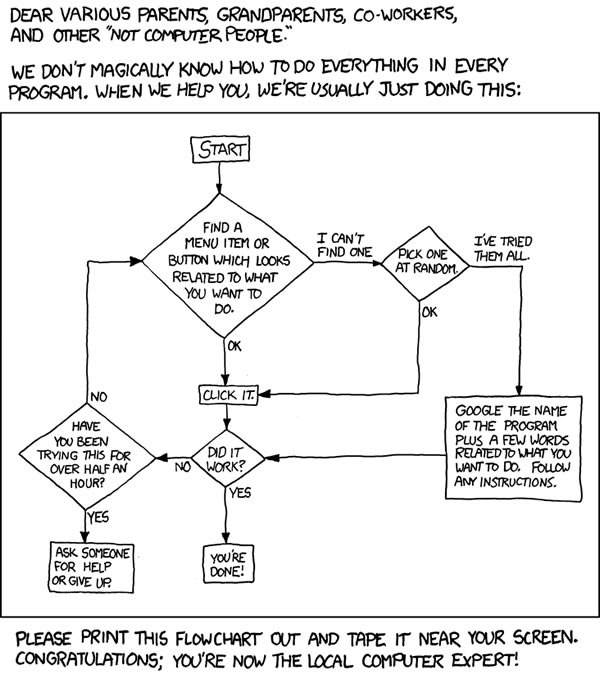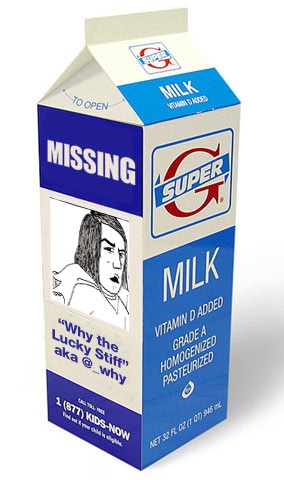If you want to attend TechDays Vancouver (September 14 – 15) or TechDays Toronto (September 29 – 30) at the early bird rate, you’ve got 3 days left! After Monday, August 31st, you’ll have to pay the full $599. Register now and save!
The TechDays $299 Deal
The Early Bird Price is Going Away Soon
The $299 early bird pricing for TechDays Canada 2009’s Vancouver and Toronto stops will vanish after Monday, August 31st. From September 1st onward, if you want to catch TechDays in Vancouver (Monday, September 14th – Tuesday, September 15th) and Toronto (Tuesday, September 29th – Wednesday, September 30th), you’ll have to pay the full price of $599. Why pay double when you don’t have to?
The TechDays Formula
Continuing with this article’s theme of using pictograms to explain things, here’s TechDays in a nutshell, pictorial-style:
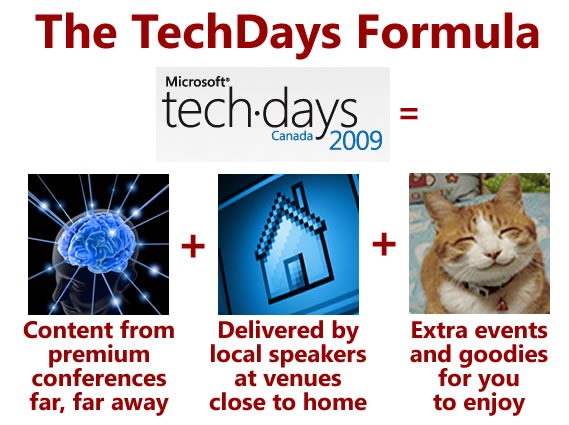 We take presentation sessions that cover getting the most out of current and new Microsoft tools and technologies from big conferences like TechEd, which are typically held in a large city in the southern United States, at a large convention centre, near large hotels and will set you back a couple “large” for registration, transportation and accommodation. TechDays 2009 features over 40 sessions split into these tracks:
We take presentation sessions that cover getting the most out of current and new Microsoft tools and technologies from big conferences like TechEd, which are typically held in a large city in the southern United States, at a large convention centre, near large hotels and will set you back a couple “large” for registration, transportation and accommodation. TechDays 2009 features over 40 sessions split into these tracks:
- Developing for the Microsoft-Based Platform
- Developer Fundamentals and Best Practices
- Windows Client
- Servers, Security and Management
- Communications and Collaboration
We update that content where necessary and find local speakers to present it. We pick out speakers who are either well-versed in the session topic or who are simply bright techies with a thirst for knowledge, a knack for presenting and who have been meaning to get well-versed in that topic. Whenever possible, we try to get someone who lives in the area of the conference city, because TechDays isn’t just about spreading knowledge; it’s also about helping developers make connections with their peers nearby.
We also set up extra events and goodies. Attendees get a one-year subscription to TechNet, which alone is worth more than the price of the early bird registration and gets you access to all kinds of goodies including Windows 7. There’s also all the content from the TechEd conference. You also get the learning kit DVD packed with goodies to help you get the most out of Microsoft’s tools and tech. We’re throwing in some discount codes for books. We’ll also be announcing surprise events in your city – watch this space for details!
And last but not least, don’t underestimate the job-and-employee-seeking opportunities that a gathering like TechDays provides. Events like TechDays are where opportunities happen!
All This for $299
And don’t forget, that’s $299 Canadian, for content from conferences that cost 7 times as much. And with extra goodies such as a TechNet subscription (which costs more than the early bird fee and gets you Windows 7) thrown in. Plus a chance to meet up with your peers as well as us evangelists, whom you should think of as “your people on the inside”. It’s a great deal, and it’s going away after next Monday, so sign up now!
GigPark Acquired by CanPages
 Local business search site Canpages has just acquired GigPark, the social networking site for employers and job-seekers.
Local business search site Canpages has just acquired GigPark, the social networking site for employers and job-seekers.
Here’s a snippet from Canpages’ news release:
"Online recommendations, especially those from a user’s social networks, are increasingly important when choosing which local businesses to buy from," said Olivier Vincent, President and CEO of Canpages. "With the acquisition of the GigPark, we are thrilled to be the first local search and directories publisher in North America to embrace social recommendations in a relevant way."
(I thought I was the only person to refer to the company as “The GigPark” – although ironically, as in “The Facebook” or “The Twitter”.)
GigPark are based here in Toronto, and founders Pema Hegan and Noah Godfrey are pillars of the Toronto tech community as well as all-round great guys, as are their team: Gianni Chiappetta, Paul Dowman and Tony Targonski. To echo the words of Jevon MacDonald at StartupNorth, it’s hard not to like them.
GigPark answers a few questions about their acquisition in their most recent blog entry:
Who is Canpages?
Canpages is the fastest growing local search and directories publisher in Canada. On its way to becoming the market leader in local online search, Canpages’ website gets more than 3.5 million unique visitors per month and is a pretty awesome place to find a local business. Its iPhone and Blackberry apps are pretty sweet too. They also publish 84 print directories that reach 8 million households and business across the country.
And the icing on the cake is that Canpages is run by a bunch of really smart and nice people (shout out to our new colleagues!)
What’s going to happen to GigPark?
GigPark is not going anywhere. We will continue to be the easiest place to find the local services your friends use. And with Canpages’ support and resources, GigPark will become even more useful.
How will GigPark play with Canpages?
The acquisition enables Canpages to integrate GigPark’s recommendations into its online and mobile search platforms. Like we said, Canpages is already a pretty awesome place to find local businesses and the addition of GigPark will make this local search experience even better.
Beyond that, Canpages is also excited about the prospect of adding some of GigPark’s social functionality to better connect users with advertisers through recommendations from friends.
I’m a business owner on GigPark. What does this mean for me?
It means A LOT more people are going to see the testimonials for your business and you’ll likely get even more business. You’re welcome! :)
The acquisition was also covered by The Globe and Mail.
Congrats to the folks at GigPark!
Last month, I posted a video announcing the launch of the Race to Market Challenge, a competition that challenges you to add some Windows Phone applications to our up-and-coming Marketplace and compete for one of four grand prizes: developer editions of a Surface table.
There’s a new video out, and I’m posting it as a little reminder for you would-be mobile developers, Windows Phone is a great way to get in on the ground floor of the world of mobile application development and win prizes at the same time:
I’ll be posting articles about how to access useful data and features on Windows Phone, including the Pocket Outlook Object Model (POOM, which gives you access to things like contact information) and using the GPS to get the user’s location.
XKCD’s Tech Support Flowchart
Give this to your non-techie friends and relatives who keep hitting you up for tech support:
Chances are, as a reader of this blog, people ask you to explain Twitter to them. If that’s the case you might find this video in which Ben Stiller explains Twitter to Mickey Rooney amusing:
How and Where is _why?
A Little Bit About _why
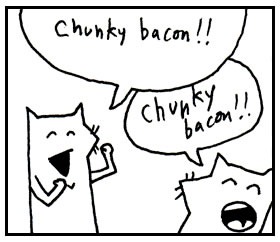 If you were to walk up to someone and utter the seemingly meaningless phrase “Chunky bacon!” and get a smile rather than a look a bewilderment, you could probably mark that person down as a Ruby programmer. That strange two-word combination is seared in the minds of those who have read what is probably the most whimsical programming language book in existence, Why’s (Poignant) Guide to Ruby. The book is one of the strange and beautiful Ruby-related works created by the enigmatic programmer, musician, artist, comic illustrator and wag known only as why the lucky stiff, or _why for short.
If you were to walk up to someone and utter the seemingly meaningless phrase “Chunky bacon!” and get a smile rather than a look a bewilderment, you could probably mark that person down as a Ruby programmer. That strange two-word combination is seared in the minds of those who have read what is probably the most whimsical programming language book in existence, Why’s (Poignant) Guide to Ruby. The book is one of the strange and beautiful Ruby-related works created by the enigmatic programmer, musician, artist, comic illustrator and wag known only as why the lucky stiff, or _why for short.
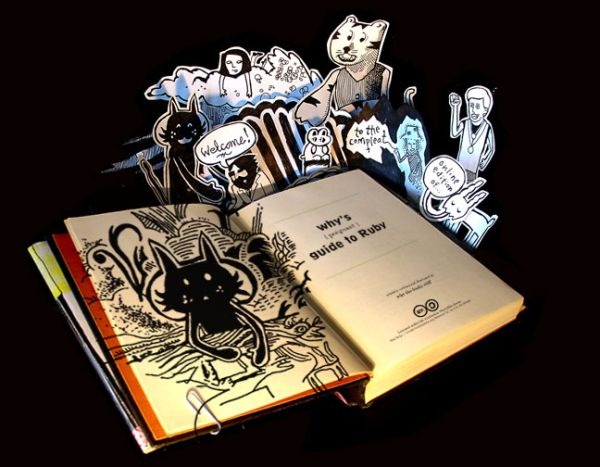
_why’s contributions to the world of Ruby programming are many. In addition to the (Poignant) Guide, some of his goodies that I’ve made use of are:
- Camping, an incredibly tiny Ruby web application framework
- Hackety Hack, a “coder’s starter kit” for Ruby, meant to bring back the spirit of experimentation of those days when the BASIC programming language was built into every home computer
- Hpricot, a parser that’s great at scraping HTML and even parsing XML
- Redcloth, a library that implements the Textile markup language
- Shoes, a desktop UI toolkit
- Syck, a YAML library
_why made it a point to reveal as little about himself as possible, and most of us were happy to indulge him. Most people were happy to simply know and address him as “why”, and in the community, it was a point of etiquette to not try and dig too deeply.
_why Vanishes from the Net
Yesterday, _why’s presence vanished from the web. The places online where you could find him have been taken down. These included:
- His Twitter account
- His Github account
- His old blog at whytheluckystiff.net
- Hackety.org, his last active blog
- The (Poignant) Guide site
- The Shoes site
- The Try Ruby site
John Resig has written a lovely “eulogy” for _why, and while I think it’s premature to say that he’s gone forever, it’s still nice to see a nice tribute to him. My favourite part of the eulogy is where John likens _why’s works to a sand mandala:
Sand mandalas are incredibly intricate works of art that take many people many days to construct. They’re very expressive, but fragile, works of art.
After a mandala has been constructed – and displayed – it is ceremoniously deconstructed – which is meant "to symbolize the Buddhist doctrinal belief in the transitory nature of material life."
_why’s entire online presence and code was presented in the sand mandala that was ‘_why’. The person behind ‘_why’ simply decided to move on and close that portion of his life.
I hope that _why’s disappearance is a brief hiatus. The Ruby world – hey, the programming world, the art world, the music world too – just isn’t the same without him.
Finding _why’s Stuff
There’s only one problem with _why’s deletion of his online presence: a number of people have come to depend on his works, particularly his code. The (Poignant) Guide is downloadable from Scribd, and I figure that if it hasn’t happened already, someone will start a Github repository of his code. There’s also Facebook group called Missing why the lucky stiff — let’s hope it doesn’t get all maudlin and support-group-y.
Last but not least, there’s programmer Leah Culver, who commissioned a tattoo from _why:
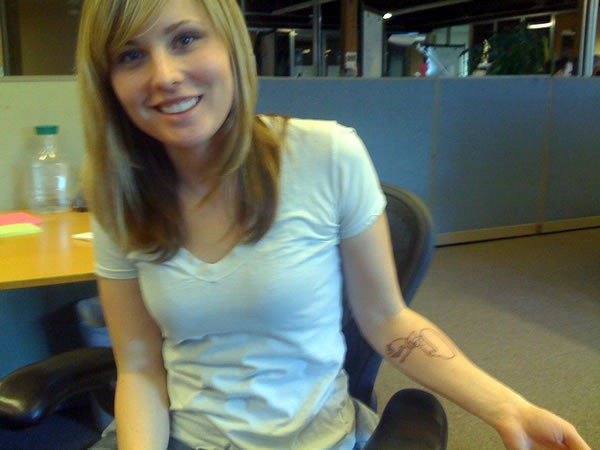
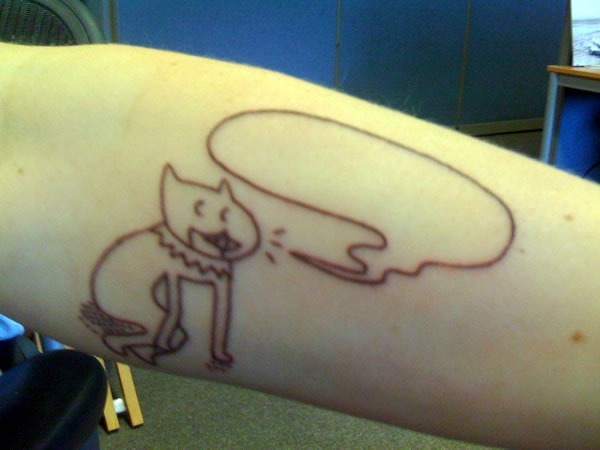
In Closing
I’ll finish with my favourite tweet from _why, which I blogged about a year ago:
when you don’t create things, you become defined by your tastes rather than ability. your tastes only narrow & exclude people. so create.
